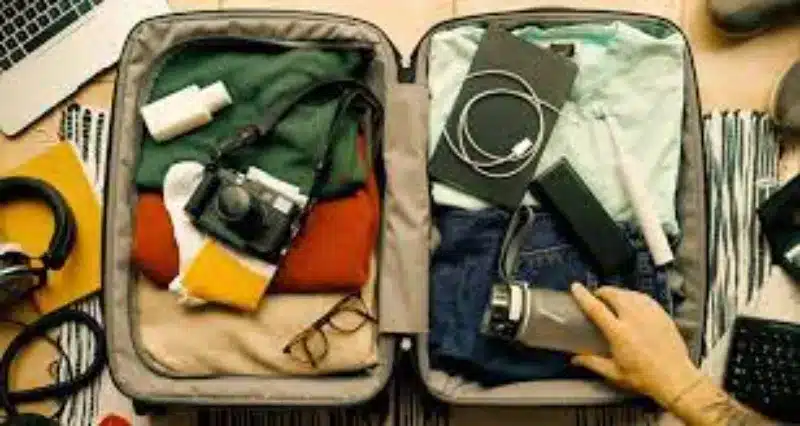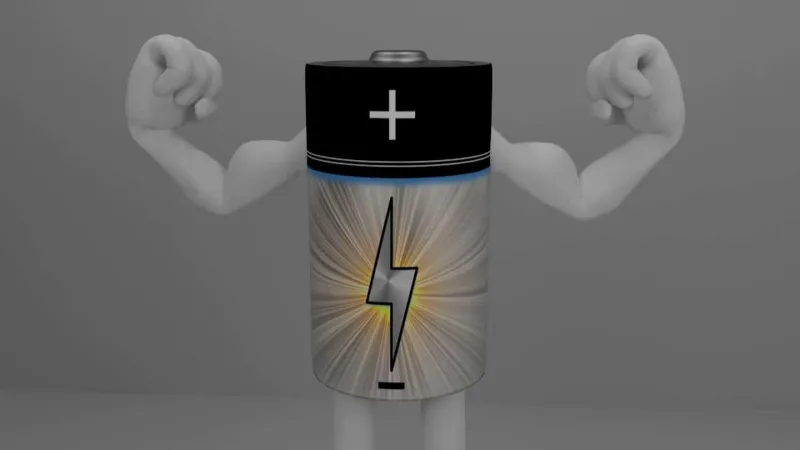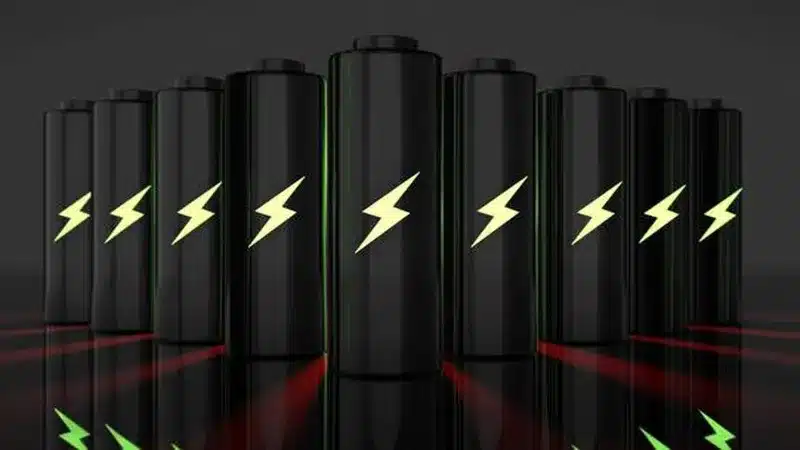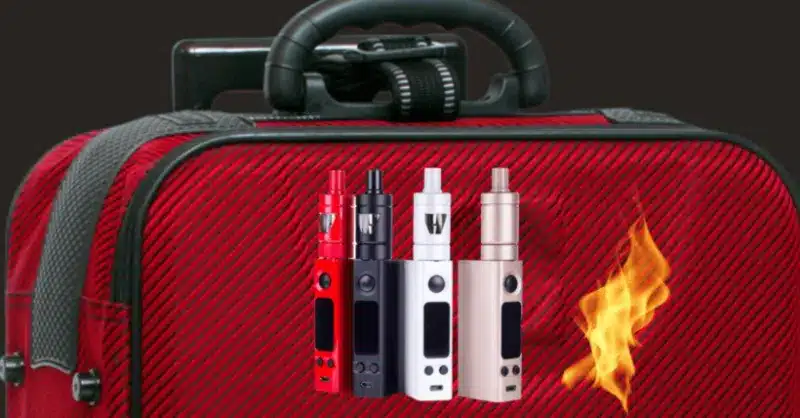Have you ever faced the panic-inducing moment of realizing you accidentally left a battery in your checked luggage? This is a common predicament for many travelers. With our lives revolving around electronic devices, it’s not surprising that one might forget to remove spare batteries from their luggage before checking in. But, it could lead to complications like delayed baggage, confiscation of the item, or even a fine.
How can you handle this situation effectively and avoid such mishaps in the future? The good news is, our comprehensive guide offers practical solutions and tips to manage and prevent this issue, ensuring peace of mind during your travels. Click the link to read our article “Accidentally Left Battery In Checked Luggage – How to Handle the Situation” and travel smarter.

What Is Checked-In Luggage?
Checked-in luggage, also known as hold luggage, refers to larger items of luggage that passengers travel with but are not allowed to carry into the cabin of a plane. These items are stored in the plane’s cargo hold during the flight. The size, weight, and quantity of checked-in luggage allowed often vary depending on the airline, the ticket type, and sometimes the route.
When a passenger checks in their luggage, it is tagged with a unique barcode by the airline’s staff. This barcode is used to track the luggage as it moves through the airport’s conveyance system, onto the plane, and finally to the destination airport. Upon arrival, passengers retrieve their checked-in luggage at the baggage claim area. It’s essential for passengers to adhere to their airline’s rules regarding checked-in luggage to avoid potential additional charges or other inconveniences.
Batteries That Are Allowed In Carry-On Bags

According to the Transportation Security Administration (TSA), passengers are allowed to bring batteries in carry-on bags with certain restrictions. Common batteries such as AA, AAA, C, D, 9-volt, and button sized cells used in consumer electronics are all permitted. Likewise, rechargeable batteries (including lithium-ion and NiMH types) and portable power banks typically used to charge cell phones and laptops are allowed.
However, spare (uninstalled) lithium batteries are limited to carry-on bags due to their potential for damage in the cargo hold. Also, any battery designed to power a wheelchair must meet specific packaging requirements. Always check with your airline and the TSA for the most up-to-date information.
Batteries That Are Allowed In Checked Luggage
According to the Transportation Security Administration (TSA), most batteries can be safely transported in your checked luggage while traveling. This includes alkaline, NiMH, NiCad, and miscellaneous household batteries. These are generally permissible as they pose a low risk of causing significant harm.
However, there are some exceptions. Lithium batteries, which are commonly found in laptops and smartphones, are allowed in checked luggage, but they must be installed in the device they are intended to power. Loose lithium batteries are not permitted in checked luggage due to the risk of short-circuiting and potentially causing a fire. It’s always best to check with your airline and the TSA for the most current rules and restrictions.
Batteries That Are Completely Forbidden To Carry

Despite the leniency with most batteries, there are certain types that are completely prohibited from being carried in both checked and carry-on luggage. The most notable among these are car batteries, wet cell batteries, and spillable batteries. These pose serious safety risks due to their potential for leakage, which can cause damage to the aircraft and potential health hazards for passengers.
In addition, certain types of lithium batteries, specifically those exceeding a rating of 100 watt-hours (Wh), are forbidden. These high-capacity batteries could potentially cause a serious fire if they were to short-circuit. Always consult your airline’s policies and the regulations of the Transportation Security Administration (TSA) before packing batteries in your luggage. These guidelines are designed for everyone’s safety and compliance is mandatory.
Are Installed Lithium Batteries Safe In Checked Luggage?
According to current regulations of the Transportation Security Administration (TSA), lithium batteries installed in a device are generally considered safe in checked luggage. This rule applies to common electronic devices such as laptops, smartphones, tablets, and digital cameras. The rationale behind this regulation is that the device itself provides a level of protection to the battery, minimizing the risk of damage or short-circuit that could potentially lead to a fire.
However, it’s important to note that even installed batteries should be handled responsibly. Ensure the device is either turned off or in airplane mode to prevent accidental activation during the journey. For devices with removable batteries, it’s recommended to separate the battery from the device if possible and protect the terminals with tape to avoid any risk of short-circuiting. Always consult with your airline and the TSA for the most up-to-date travel guidelines regarding lithium batteries.
Which Lithium Batteries Are Allowed In Carry-On Luggage?

When it comes to carry-on luggage, the rules for lithium batteries are somewhat more lenient. Passengers are allowed to bring lithium-ion batteries with a rating of up to 100 watt-hours (Wh) in their carry-on baggage. This typically includes batteries for laptops, smartphones, tablets, and other personal electronic devices.
In addition to this, the Federal Aviation Administration (FAA) allows passengers to bring up to two spare batteries with a rating between 100 and 160 Wh in their carry-on luggage. These might include some larger laptop batteries or professional-grade audio and video equipment. However, these spare batteries must be individually protected to prevent short circuits. This can be done by keeping them in their original retail packaging, placing each battery in a separate plastic bag, or covering battery terminals with tape. As always, for the most accurate information, passengers should refer to their airline’s specific policies and the TSA’s guidelines.
Accidentally Left Battery In Checked Luggage
Accidentally leaving a battery in checked luggage can potentially cause problems as airlines have specific regulations concerning the transportation of batteries. Certain types of batteries, particularly lithium batteries, can pose a safety risk as they are capable of igniting and causing a fire.
For this reason, batteries are generally required to be transported in carry-on baggage where they can be accessed quickly by cabin crew in case of an emergency. If you accidentally leave a battery in your checked luggage, it might be removed by security personnel during luggage screening. Always remember to check airline policies concerning battery transportation to ensure a smooth and safe journey.
What Should You Do To Resolve This Problem?

If you discover that you have inadvertently left a battery in your checked luggage, your immediate course of action should depend on your current location. If you are still at the airport and have not yet checked in your luggage, you should inform airline staff about the situation promptly. They can guide you on how to handle it, which most likely involves removing the battery from your checked luggage and placing it in your carry-on.
In cases where you realize this after your luggage has been checked in, the best course of action would be to alert the airline staff immediately and cooperate with them to resolve the issue. Depending on airport policies and procedures, they may be able to retrieve your luggage in order to remove the battery. However, if the luggage has been loaded onto the plane, it may be more complicated. The airline will determine the most appropriate course of action in accordance with safety regulations and policies. Always remember to review and adhere to airline battery regulations in the future to avoid such issues.
Does The TSA Scan Checked Luggage For Lithium Batteries?

Yes, the Transportation Security Administration (TSA) scans all checked and carry-on baggage for prohibited items, including certain types of lithium batteries. Lithium-ion batteries exceeding a certain wattage are not allowed in checked luggage due to their potential for causing fire hazards. These batteries are most commonly found in electronic devices like laptops, cameras, and smartphones.
However, most personal devices that you typically carry in your luggage are within the allowable limit. It’s always a good idea to check the latest TSA guidelines when packing, especially for international travel where regulations may vary. If a lithium battery were found during the scanning process that was not allowed, the item could be removed from your luggage.
Safely Packing Batteries For Your Trip

Make A List
When preparing for your trip, making a detailed list is crucial for safely packing batteries. Identify all the electronic devices you’ll be bringing and jot down the type and quantity of batteries each device requires. This not only ensures you’ll have ample supply, but also helps in organizing them properly.
Consider the battery regulations of your airline and the countries you’ll be visiting as certain types may not be allowed. Always remember to pack spare batteries in carry-on luggage as checked luggage can expose them to extreme temperatures. Including a travel-approved battery case on your list will ensure secure and safe transportation of your batteries.
Label & Bag
When it comes to safe packing for a trip, batteries require special attention. Batteries, especially lithium ones, can pose a risk if they are not properly packed. A label and bag system is essential for safely storing your batteries. Always use clear, well-marked bags for your batteries. This helps airport security, and anyone else who might handle your luggage, easily identify and handle them appropriately.
Attaching a label on the bag detailing the battery type and potential risks can further enhance safety. It’s also a good idea to include a note on how to safely dispose of the batteries. This way, you’re not only ensuring your trip is seamless, but also contributing to responsible and safe handling of batteries.
Transport Safety

Traveling with batteries requires careful planning and proper packing to ensure safety. Batteries, especially lithium batteries, can potentially cause dangerous situations if not handled correctly. They should always be kept in their original packaging or in separate plastic bags to avoid short-circuiting.
If you’re carrying spare batteries, it’s crucial to cover the terminals with insulating tape or place each battery in a separate plastic bag. Never let the terminals of different batteries touch each other. Moreover, keep them away from metal objects such as coins, keys, or jewelry, as these can connect the positive and negative terminals and cause a short circuit. It’s also recommended not to pack batteries in the luggage that you check in, but rather to keep them in your carry-on luggage where they can be managed more carefully.
Be Safe
When traveling, it’s crucial to safely pack your batteries to prevent any possible accidents. Always protect the terminals by covering them with the original caps or with non-conductive materials such as electrical tape. Make sure to store batteries in a cool, dry place, away from metal objects that could cause short circuits. Also, always remember to carry spare batteries in your carry-on bags rather than checked luggage, as they are susceptible to extreme temperatures and rough handling.
Can We Take Lithium Batteries In Checked Luggage

Power Banks With Lithium Batteries Of Less Than Or Up To 100-watt Hours
Traveling with power banks that contain lithium batteries of less than or up to 100-watt hours in checked luggage is subject to various regulations. According to the Federal Aviation Administration (FAA), these devices must be carried in carry-on baggage only. This is due to the potential fire risks associated with lithium batteries. If a fire were to occur, it could be noticed and extinguished more quickly in the cabin than in the cargo hold.
However, you should always check with your specific airline as rules can vary. For example, some airlines may allow you to bring these power banks in checked baggage if they are turned off and protected from damage, while others may not permit them at all. If you’re traveling internationally, be sure to research the regulations of the country you’re visiting as well. It’s always best to be prepared and informed to avoid any potential issues at security.
Power Banks With Lithium Batteries Of More Than 100-watt Hours
When it comes to carrying power banks with lithium batteries of more than 100-watt hours in checked luggage, the regulations become even more stringent. The FAA stipulates that these power banks are not allowed in checked baggage due to the higher potential fire risk these larger batteries pose. As with smaller batteries, the idea is that a fire caused by a lithium battery in the cabin can be dealt with more swiftly and effectively than one in the cargo hold.
In certain cases, with airline approval, passengers may carry up to two spare larger lithium-ion batteries (101-160 watt hours). However, these must be carried in carry-on baggage only. The devices must also be protected from damage and short circuit. Again, the guidelines can vary from one airline to another and from one country to another, so it’s essential to check with your airline and the relevant authorities in the countries you’re traveling to and from. Always ensure you’re up to date with the most recent regulations to avoid any potential hiccups during your journey.
Can We Take Phone Chargers In Hand Luggage

Absolutely, you can take phone chargers in hand luggage. There is no security regulation against carrying chargers for personal electronic devices, such as smartphones, laptops, or tablets, in your carry-on baggage when flying. It’s always a good idea to keep these items in your carry-on, as it ensures you can stay connected during your journey or upon arrival.
However, it’s crucial to be aware of the specific rules regarding battery packs or power banks. According to the TSA (Transportation Security Administration), power banks fall under the category of spare lithium batteries. These must be placed in carry-on baggage and are not allowed in checked luggage due to safety concerns.
It’s also worth noting that while phone chargers and power banks are generally permitted, it is advisable to check the airport or airline specific policy regarding these items. Some airlines might have specific restrictions or guidelines on carrying such electronic devices or equipment.
Lastly, it’s essential to ensure that these items are packed in a way that they can be easily removed from your bag for inspection. At security checkpoints, you may be asked to remove these items from your luggage, especially if they are large or have a high battery capacity. By being aware of these rules and tips, you can ensure a smooth travel experience.
The Right Power Bank For Bringing On A Plane

Choosing the right power bank for air travel involves consideration of several crucial factors. First and foremost, airport regulations often limit the size of power banks that passengers can bring on planes. In most cases, this is measured in milliamp hours (mAh), with a common maximum limit of 20000mAh or 100Wh. It’s essential to check the specific guidelines of your airline before travel.
In addition to capacity, the type of battery used in your power bank can also affect its suitability for air travel. Lithium-ion batteries, for instance, are generally accepted due to their efficiency and longevity. However, some airlines may have restrictions on the number of such devices a passenger can carry.
Another crucial consideration is the charging speed of your power bank. If you’re carrying multiple devices or plan to use your devices heavily during the flight, a high-speed power bank can ensure that they stay powered throughout your journey. Look for power banks that support fast charging standards compatible with your devices.
Lastly, ease-of-use can significantly influence your in-flight experience. Opt for a power bank that is compact and lightweight, making it convenient to carry in your hand luggage. Some power banks also feature built-in cables, eliminating the need to carry extra cords.
By carefully considering these factors, you can select a power bank that not only meets airline regulations but also suits your personal travel needs. Remember to always check with your airline for their specific guidelines regarding power banks.
FAQs About Accidentally Left Battery In Checked Luggage

What Are The Potential Risks Of Leaving A Battery In Checked Luggage?
The primary concern is the risk of fire. Batteries, particularly lithium-ion batteries, can overheat and catch fire under certain circumstances. In an airplane’s cargo hold, such a fire could have dire consequences and is hard to extinguish. Therefore, airlines have strict regulations prohibiting batteries in checked luggage.
What Should I Do If I Realize I’ve Left A Battery In My Checked Luggage?
If you realize this before your flight and you are still at the airport, the best course of action is to inform airline personnel immediately. They can assist you in retrieving your luggage and removing the battery. If you have already boarded the plane or have arrived at your destination, it is important to notify the airline as soon as possible, so they are aware of the situation and can take appropriate action.
What Are The Penalties For Accidentally Leaving A Battery In Checked Luggage?
The penalties can vary depending on the airline and the country in which you are traveling. Some airlines may issue a warning for first-time offenders, while others may impose fines. In some cases, serious violations can lead to a ban from the airline. However, it’s essential to note that these penalties generally apply to those who knowingly violate the rules. If you left a battery in your checked luggage accidentally, it may be treated differently, especially if you report it promptly.
Is It Possible To Bring Batteries In My Carry-On Luggage?
Yes, you can bring batteries in your carry-on luggage as long as they meet the airline’s restrictions. Generally speaking, lithium ion and lithium metal batteries must have a charge of no more than 100Wh for most airlines. Other types of batteries such as lead-acid, nickel-cadmium and alkaline batteries are typically allowed. Be sure to check with your airline’s policies before packing any batteries in your carry-on luggage.
Conclusion
In conclusion, accidentally left battery in checked luggage is a common mistake that many travelers make. However, it’s a situation that can lead to serious consequences, including potential fire risks during flight. Airlines and aviation authorities worldwide stipulate strict guidelines regarding the transportation of batteries in checked baggage due to these safety concerns. As responsible travelers, it is imperative to familiarize ourselves with these regulations and ensure we abide by them. This not only ensures our safety but contributes to the overall safety and efficiency of air travel.